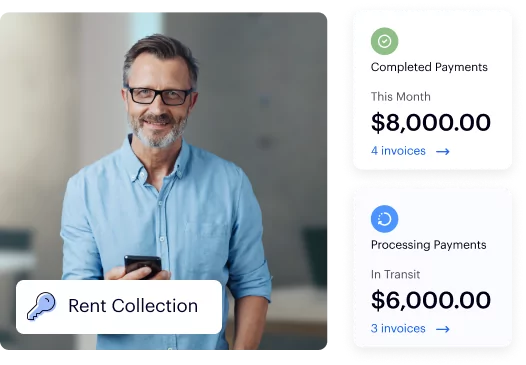Screening tenants is a non-negotiable step for filling vacancies when you consider the average eviction costs about $3,500 if you factor in everything from legal and court fees to lost rent and the costs for repairs, cleaning, and screening for a new tenant. That’s a hefty price to pay for not doing your homework upfront.
It’s tempting to go with your gut or make snap judgments based on first impressions, but there are better approaches than that. This guide will walk you through how to screen potential tenants properly while complying with fair housing laws.
Key takeaways:
- Investing time in thorough tenant screening upfront can save you thousands down the line in dealing with unpaid rent or evicting squatters.
- The tenant screening process includes detailed applications, rental history checks, credit and background checks, and in-person showings.
- Check the Fair Credit Reporting Act (FCRA) and Fair Housing Laws for guidelines on how to properly and fairly deny rental applicants.
- Maintaining thorough records protects you and ensures transparency throughout the screening process.
- Choose a reliable tenant screening service that goes beyond basic background checks and credit scores so you can find reliable renters and avoid fraud.
Why screening tenants matters
With eviction filings spiking nearly 50% above pre-pandemic levels in some cities, investing time in how to screen renters properly upfront can help you avoid becoming part of this statistic.
| TOP 5 CITIES FOR EVICTION FILINGS | ||
|---|---|---|
| City | Filings | Relative to Pre-Covid Average |
| Minneapolis–Saint Paul, MN | 12,997 | +60% |
| Austin, TX | 13,161 | +43% |
| Gainesville, FL | 1,897 | +41% |
| Columbus, OH | 25,159 | +37% |
| Nashville, TN | 14,034 | +37% |
Tenant screening is your first line of defense against expensive evictions and legal battles. With 58% of renters considering moves in the next year, a thorough screening process helps you find reliable tenants who pay on time, respect your property, and are more likely to stick around—saving you time, money, and stress in the long run.

When should you start looking for new tenants?
The ideal time to begin looking for new tenants is 30 to 60 days before the lease expires. Starting early gives you enough time to create your rental listing, screen applicants, and avoid extended vacancies. This timeframe also provides your current tenant with adequate notice to find a new home if they plan to move out.
Managing property viewings while an existing tenant still lives there can be challenging. Here are some tips to make the process smoother:
- Give plenty of notice: Depending on your location, the law typically requires giving 24 to 48 hours of notice before entering the property. However, offering more advance notice can foster goodwill and cooperation.
- Schedule group showings: To respect your tenant’s privacy and minimize disruption, schedule group showings rather than frequent individual appointments.
- Hire a professional cleaner: If the tenant’s living space needs sprucing up for viewings, offer to hire a cleaner to ensure the property is well-presented.
Make sure you know where to advertise your property to find the best tenants. Popular platforms like Zillow and Apartments.com can help fill your vacancy fast. Read our guide for expert tips on how to attract good tenants and what they want to see in your rental listing.
How to screen tenants: Step-by-step guide
The screening process varies depending on the service you choose, but here’s a general overview of the steps for screening rental applicants:
Here’s a simple step-by-step process to verify a tenant’s rental history.
Step 1: Set tenant screening criteria
When setting benchmarks for potential tenants, consider the following:
Income requirements
Establish a clear income-to-rent ratio to ensure tenants can afford the rent. A common benchmark is three times the monthly rent. For example, if your rent is $1,500, the tenant should earn at least $4,500 per month. Setting the bar too low can attract problem tenants, while too high a requirement might leave your investment property vacant.
Credit score
A credit score is a key indicator of financial reliability. Scores range from 300 to 850, with higher scores reflecting better creditworthiness. Most landlords require a minimum score of around 620 to 650 for tenant approval. Scores below 600 indicate potential financial risk, requiring further investigation or a co-signer.
5 key factors that affect credit scores:
- Payment history (35%): Whether tenants pay their bills on time.
- Credit utilization (30%): How much credit a tenant is using compared to their total credit limit.
- Length of credit history (15%): How long a tenant has had active credit accounts
- Recent credit inquiries (10%): Lenders that have requested credit checks for loans.
- Public records (10%): Any public financial records, such as bankruptcies or liens.
Eviction history
Background checks reveal past evictions and criminal records, offering insight into potential risks. When reviewing background checks:
Criminal and eviction history
Background checks reveal any criminal offenses or past evictions, offering insight into potential risks. When reviewing criminal records:
- Look for specific offenses: Focus on crimes in the past year related to violence, property damage, or fraud, as these may directly affect safety or financial stability.
- Avoid blanket exclusions: Follow Fair Housing Laws by evaluating each record individually and avoiding automatic rejections based on arrests that didn’t lead to convictions.
- Consider key factors:
- Nature and severity of the offense.
- Time elapsed since the incident.
- Evidence of rehabilitation or mitigating circumstances.
For eviction history:
- Identify patterns: Pay attention to repeated evictions in the past five years, especially for non-payment or lease violations.
- Isolated incidents: Evaluate whether a single eviction was due to extenuating circumstances, such as medical emergencies or job loss.
- Verify details: Cross-check information with previous landlords to ensure accuracy.
Establishing clear, written policies for evaluating eviction history ensures consistency, compliance with legal standards, and fair treatment of all applicants.
Step 2: Request a rental application
Ensure potential tenants complete a detailed rental application covering personal information, rental history, employment, income verification, and references. This form establishes the groundwork for an effective screening process.
Step 3: Pre-screen tenants
Use your rental ad to filter out unqualified applicants upfront. Include:
- Smoking policy: Clearly state whether smoking is allowed on the property.
- Pet policy: Specify if pets are allowed, and if so, provide details on the size, breed restrictions, and any associated pet deposits.
- Lease term requirements: Outline the preferred lease duration, such as month-to-month or annual.
- Income and deposit expectations: Mention the required income-to-rent ratio and the deposit amount.
Additionally, during initial conversations, ask qualifying questions to confirm if the applicant meets your basic requirements. This step helps save time and narrows down the number of suitable candidates.
Here are key questions to ask during this meeting:
- What is your monthly income?
- What’s your reason for moving?
- How many people will be living in the apartment?
- Do you have pets, and if so, what kind?
- What is your typical workday schedule?
- Have you already given your current landlord notice?
- How long do you plan to stay?
Steer clear of intrusive or discriminatory questions to keep yourself within legal boundaries. Here’s a complete list of tenant screening questions to ask potential renters to get the full picture while staying compliant.
Step 4: Check rental history
Contact current and previous landlords for a rental history check to assess the tenant’s reliability and rental behavior. Key questions to ask include:
- Did they pay rent on time?
- Did they leave the property in good condition?
- Were there any disputes during their tenancy?
Cross-reference responses with the application for consistency. Watch for issues such as previous property damage or frequent moves, which may indicate instability or problematic behavior.
Examples of useful findings:
- Gathering feedback on the tenant’s behavior
- Learning that a tenant had disputes over security deposit deductions
- Discovering a tenant has a history of frequent moves
- Previous property damage record
Step 5: Verify income and employment
Make a call to confirm the applicant’s employment history and status:
- Employment verification: Contact employers to confirm job stability and income. Use publicly available contact details to avoid fraud.
- Income verification: Request proof of income, such as recent pay stubs, tax returns, or bank statements. Ensure the tenant meets your income-to-rent ratio requirement, typically three times the monthly rent.
Tip: When reaching out to verify employment, don’t rely on the contact details provided by the applicant. Over 83% of landlords reported receiving false employment and income documents from rental applicants in 2024. Look up the employer’s contact information online to ensure authenticity and avoid potential fraud.
Step 6: Run credit and background checks
Use a tenant screening service to check credit history and background records. Review:
- Credit history for missed payments or excessive debt.
- Criminal records, focusing on offenses that could impact safety or property.
- Eviction history (recent evictions can negatively affect credit scores).
Some services provide limited information, only credit scores or local background checks—which isn’t sufficient for a thorough evaluation. A solid service should dig a little deeper, providing a broad range of data for a more accurate risk assessment.
Baselane provides a full Equifax credit report and searches 1.8 billion criminal records for a comprehensive tenant evaluation background check that will help you make informed decisions about who you’re handing the keys over to.
Step 7: Schedule an in-person showing
Meet potential tenants during a property showing to evaluate their demeanor and interest in the unit. This is also an opportunity for tenants to ask questions and confirm that the property meets their expectations
What to observe:
- Are they respectful and polite?
- Do they ask thoughtful questions about the property?
- Do they seem reliable and responsible?
Example: A potential tenant who arrives late without notice might be less reliable when it comes to paying rent on time.
Step 8: Accept or deny tenant
After completing the screening process, promptly inform applicants of your decision. For accepted tenants, provide the lease agreement and outline the next steps for signing and move-in. For rejected applicants, consider providing a brief, professional explanation and ensure compliance with the Fair Credit Reporting Act (FCRA).
According to some state and local fair housing laws, landlords must also not discriminate based on marital status, sexual orientation, age, veteran status, political ideology, language, or culture.
Examples of Fair Housing violations
Here are some examples of what may be considered illegal discrimination under the law:
- Refusal based on race: A landlord declines an application after noticing the applicant has a traditionally African American name, assuming they might not fit into the predominantly white neighborhood.
- Selective amenities: Upon learning a tenant’s religious background, a landlord decides not to offer access to the building’s newly renovated gym.
- Inappropriate questions: During a viewing, a landlord asks a couple whether they plan to have more children, suggesting that the quiet community prefers fewer children.
- Ignoring disability needs: A landlord refuses to install grab bars in the shower for a tenant with a physical disability, arguing that the bathroom will lose its aesthetic appeal.
- Income source judgment: A landlord discovers an applicant uses a housing voucher to pay rent and looks for tenants who can pay without assistance.
Fair Housing Law exemptions
There are a few exemptions to this rule, including:
- Owner-occupied buildings with no more than four units.
- Single-family homes rented or sold by the owner without using an agent.
- Housing operated by religious organizations for community members.
- Renting to immediate family members.
- Renting based on age (some states and local jurisdictions may offer extra safeguards for older individuals).
Fair Housing Law violation penalties
For first-time violations, fines can reach up to $23,011. For a third violation, the amount may increase to $115,054. If the Justice Department gets involved, the penalties can escalate to as much as $150,000.
5 tips for finding reliable tenants
Here are some tips on how to vet tenants for reliability and maintain compliance:
- Host an open house: See how potential tenants interact with others and observe their behavior in a shared environment. Someone who arrives late or doesn’t treat attendees respectfully could raise red flags.
- Schedule post-meeting follow-ups: Assess how quickly and professionally they respond to emails or calls—responsiveness can signal reliability.
- Check social media accounts: Look for red flags or lifestyle habits that might not align with your lease terms or property rules. Applicants who frequently share party posts or photos showing multiple pets may not be the best fit for quiet buildings.
- Keep detailed records: Paper trails might not be exciting, but they’re important. Document communications, application details, and screening results to stay organized and compliant.
- Choose a reliable service: Use a trusted tenant screening platform to run background checks, credit reports, and verify employment and rental history.
Screen tenants for free with Baselane
Avoid bad tenants and costly evictions from the start with the right tenant screening service.
Unlike some services that charge a hefty fee for surface-level screening that only covers credit scores and local criminal records, Baselane provides comprehensive tenant screening reports to landlords in minutes for free.
Get instant access to full Equifax reports, criminal reports covering 1.8 billion national and local records, eviction reports from the largest database of U.S. housing court records, and bank-verified income. All reports include rental applications and 3-way ID verification for advanced fraud protection.
Ready to find your next great tenant? Start screening for free today.
FAQs
Landlords typically screen tenants by checking rental applications, verifying income, running background and credit reports for rental applicants, and contacting landlord and employer references.
Follow this tenant screening checklist to streamline the process and ensure you don’t miss anything.
If an applicant doesn’t meet your rental criteria, you should provide them with a professional written notice clearly stating the reasons for denial, such as issues identified when evaluating their credit history (learn more about what landlords look for in a credit check). Always keep detailed records and ensure your decision complies with Fair Housing regulations and Fair Credit Report Act guidelines.
It's best to stop looking for potential tenants once you've found an applicant who meets all your rental requirements, including good credit, steady income, positive rental references, and passing all necessary background checks. After you sign a lease and collect a security deposit, you can officially stop searching for tenants.
Baselane’s online rent collection makes it easy for tenants to pay security deposits, rent, and other fees online via ACH or card. They’ll get monthly rent reminders and can set up auto-pay to help increase on-time payments.
Common red flags when screening renters include:
- Incomplete or inconsistent rental applications
- High debt load or consistent late payments
- Frequent moves or eviction history
- Negative feedback from past landlords
- Applicants overly eager to bypass standard screening procedures
Be attentive to these signals in the beginning so you can avoid potential problems later on.
Tenant screening costs generally range between $25 and $75 per applicant. Pricing varies based on the service, available reports, and database access. Depending on the platform, tenant screening may be paid for by the landlord or the applicant.









